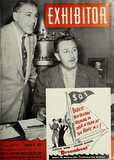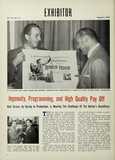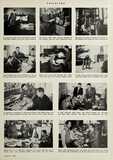


[img]In Hollywood Walt Disney shows Paul Manning, Exhibitor coast representative, a sample of "Story of Robin Hood" advertising.[/img]
[img]Manning and producer Disney talk over some matters in connection with “Story of Robin Hood”, released through RKO, with the background showing some honors Disney has won.[/img]
THESE are days when showmanship ingenuity, thought in programming, and high quality of product is more essential than ever to insure boxoffice returns profitable for the men who make pictures and for those who exhibit them. Always a leader in his field, Walt Disney is one producer who is really trying to find the key to boxoffice success by daring in production and concerted effort in selling through every exploitation channel open to him.
When he made “Snow White And The Seven Dwarfs” as the first all-cartoon feature, there were those who felt the risk would never pay off. Yet, on its third time in release, “Snow White” this year is still rated among the first 10 boxoffice successes.
Three years ago, he foresaw that the public could be intrigued only by something new, and he came up with his series of “True Life Adventures”, which, while only 30 minutes in length, are proving today their draw.
Right now, he is thinking ahead past the first of 1953, when he will have as his next all-cartoon feature, James Barrie’s fascinating “Peter Pan.”
Disney himself is thinking beyond “Pan”, and to a companion “True Life Adventure”, He is concentrating now on “Bear Country”, which he feels will be the ideal subject to go with the Barrie fantasy. He will also have another cartoon “special” to round out the show.
He knows he can only offer such a program to an exhibitor but he certainly has as much at stake as an exhibitor in developing a complete show which would bring commensurate returns to the boxoffice. After all, “Peter Pan” will cost over $3,500,000 to produce, and it’s a certainty he is one of the few producers prepared to gamble such a vast sum on any picture these days.
[img]In one of the studio music rooms, Disney consults with Oliver Wallace, one of his staff composers.[/img]
[img]The Disneys, Walt, right, and Roy, president of the company, look over some commercial tieups.[/img]
[img]Discussing some camera techniques with Disney is Bob Gibeaut, who heads the camera department.[/img]
[img]Ward Kimball, seen here with Disney, is one of the top supervising animators of the organization.[/img]
[img]Disney, on a tour of the Burbank, Cal., studio, chats with one of the young company artists.[/img]
[img]In front of the Animation building, Disney poses with Walt Pfeiffer, aide, and William Peet, artist.[/img]
[img]A storyboard development is discussed by Disney with Wilfred [Jackson], one of the several production directors who work on the cartoon features.[/img]
[img]A staff conference finds Disney with Charlie Philippi, Ken O’Connor, and Ham Luske, director, with layout and backgrounds also seen.[/img]
[img]Disney sits in on a staff story conference, and noted with him are his veteran story men, Windston Hibler, Ted Sears, and Ed Penner.[/img]
[img]Disney talks background color and design with John Hench and Claude Coats during the coordination of all the special arts of animation used.[/img]